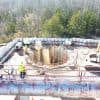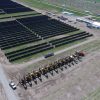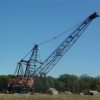PROJECT DETAILS
On August 7, 2000, work began on the blasting of the Coldwater Creek turbine / generator pedestals in the Central California Power Agency Plant #1, located near Kelseyville, CA., in a region known as “The Geysers.” The plant was built in 1988 and operated until it was decommissioned in 1994 because of inefficiency in its operation.
The Coldwater Creek generator facility was a dry steam geothermal power plant. Work is currently underway to remove the power plant and restore the area around it to the original state prior to construction.
What is Geothermal Energy?
Geothermal energy is renewable heat energy from deep in the earth. Heat is brought to the near-surface by thermal conduction and by intrusion into the earth’s crust of molten magma originating from great depth. Ground water is heated to form hydrothermal resources – naturally occurring hot water and steam. Use of hydrothermal energy is economic today at a number of high-grade sites. Hydrothermal resources are tapped by existing well-drilling and energy-conversion technology to generate electricity or to produce hot water for direct use. Earth energy is used by geothermal heat pumps. Hot dry rock, magma and geopressured geothermal energy have enormous potential.
For generation of electricity, hot water, at temperatures ranging from about 300deg.F to more than 700deg.F, is brought from the underground reservoir to the surface through production wells, and is fed to a turbine engine, which turns a generator. Spent geothermal fluid is injected back into peripheral parts of the reservoir to help maintain reservoir pressure.







